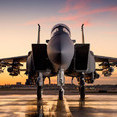
FM Speculations and Observations (FE2 and SF2)
By
VonS, in Thirdwire - First Eagles 1&2
-
Similar Content
-
By VonS
Hi All,
Have been doing a bit of tinkering lately with my FlightGear install (see this thread for more info.) - and results are pleasing enough in what is a free, open-source flight sim. Managed eventually to get accurate photo-scenery working in FG, which is a noticeable improvement over the stock (dated) scenery that has been available in that sim for years on end (see pic. below for photo-scenery at work in FG, in this case in the Mesopotamian/s. Iraqi area; the Alb. D.I is a re-skin and FM-overhaul of a model done by Lester Boffo).
On a hunch, I then converted a bunch of the photo-tiles from FG (stock format is DDS) to BMP format - so that they become visible in the FE2 terrains folder - and it does indeed work - but would require careful, aesthetic choices regarding what tiles to replace in the terrains folder, such as farms, cities, deserts, etc. - for best cohesion and not too many jarring disconnects between tiles.
Nice to see that stock trees and buildings are populating over the satellite/ortho-terrains too, in FE2. Photo-scenery is simply an improved "satellite" carpet that covers the stock scenery and terrain framework in FlightGear - and by extension works the same way in the ThirdWire sims but requires manual conversion to BMP format and manual placement in the terrains folder (perhaps the DDS format would work too, but I didn't bother tinkering with the various settings/text files this time around in the terrains folder).
The other good thing about FlightGear is that it is fully under the GNU GPL (General Public License; i.e., "copy-left" license) - so there are no copyright problems that I know of if one borrows such ortho-scenery for FE2 too (haven't bothered to test with SF2). And if working on such a terrain swap as a personal project - that is of course even simpler.
A few representative pics. below with just a few ortho-scenery tiles placed over Stephen1918's upgrade of the Mesopotamian theater for FE2. Results look pretty good, particularly when flying higher up, and I haven't noticed any FPS drop with the photo-scenery tiles loaded. Some old tiles are still in place in the pics., for comparative purposes. Any empty areas are where I didn't bother to load tiles.
Anyway - I hope you find this post interesting - it's perhaps the "cheapest" way of upgrading tiles across the various theaters available for FE2.
If I find enough free time I might tinker further with this side-project; will post comments if the results prove particularly successful.
Cheers & good flying,
-
By JamesWilson
Hi everyone,
I recently got into weapon modding and wanted to edit some missiles.
I went for the Weapons Folder with the Weapons Editor, and some weapons were missing, even tho i can see them and equip them in-game.
I wanted to edit the AA-2D Atoll for my Su-22M3, but there's no AA-2 folder inside Weapons folder, nor inside plane folder, even tho the missile is equippable and i can see it/use it in-game.
Since there's no Atoll folder, i have no idea how is it possible for me to have it in-game, and even less i know on how am i supposed to edit it through Weapons Editor, since i can't select the folder.
I thought it may be a sort of "built-in-game" missile and for this reason not showing in weapons folder (idk i just made an hypothesis).
So i tried using the CAT Extractor, but seems like not working... no matter which CAT file i select, it says "error opening this .CAT file, no files can be extracted", how's that? How do i fix it? Am i doing something wrong?
Thank you in advance for helping me fixing all these issues or helping me find what i'm doing wrong
-
By ProblemChild
I am new to this game but I am loving it and the dynamic campaign is amazing. my only and only problem is that planes just dissapear in the distance, literally just dissapear a short distance a way, around 200 - 500 meters away? not too sure but its very off putting and its clearly an issue for gameplay.
I am using Patch July 2013
Wings over Korea mod
I play on 3840x2160 4K resolution (I'd prefer playing on that) I have extracted the flightengine ini into SF2 Filght folder as well as to the korea folder and made some changes like turned off fade away and increased mesh values, but still to no avail? Anyway to fix this? Its literally the only thing destroying the fun I have with this game.
-


